-
solutinos
-
Hire
Frontend Developer
Backend Developer
-
NodeJS Developer
-
Java Developer
-
Django Developer
-
Spring Boot Developer
-
Python Developer
-
Golang Developer
-
Ruby on Rails Developer
-
Laravel Developer
-
.NET Developer
Technology
-
Flutter Developer
-
React Native Developer
-
Xamarin Developer
-
Kotlin Developer
-
Cross-Platform Developer
-
Swift Developer
-
MongoDB Developer
-
C Developer
-
Smart Contract Developers
Cloud
-
-
Services
Mobile Development
Web Development
- Work
-
Multi Services App
-
Food Delivery App
-
Grocery Delivery App
-
Taxi Cab Booking App
-
Multi Services App
-
OTT Platform APP
-
Social Media APP
-
Freelance Service App
-
Car Rental App
-
Medicine Delivery App
-
Liquor Delivery App
-
Sports Betting App
-
Online Coupon App
-
eLearning App
-
Logistics & Transportation App
-
Courier Delivery App
-
On-Demand Real Estate App
-
E-Wallet APP
-
Online Dating App
-
Handyman Services App
-
-
Process
-
Company
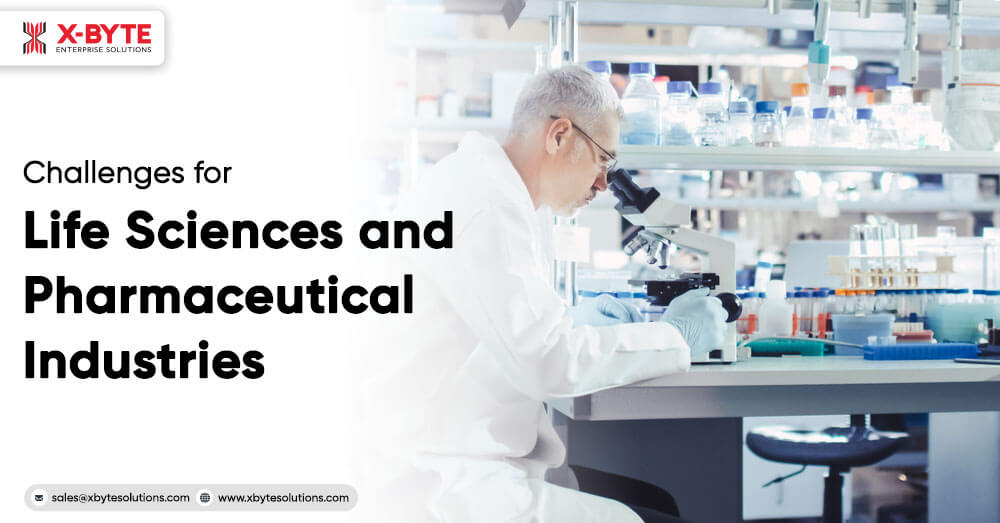
Quick Summary : The life science and pharmacy industries are transforming rapidly. They are subjected to many challenges. Addressing them requires integrating newer technologies such as AI, automation, and data analytics in research and regulatory processes to cut costs while enhancing the speed of discovery.
Hello, and welcome to the next post of our exclusive Digital Transformation in Healthcare Series. Our last post discussed the challenges and solutions in the healthcare providers’ segment. From the negative morale of healthcare staff to treatment delays due to delayed reports and data and a lack of data interoperability, we saw the shortcomings faced by healthcare professionals on a daily basis.
We also addressed their solutions extensively.
Today, we will illuminate another important wing of the healthcare system: life sciences and pharma. These two distinct segments of the healthcare sector have several common and overlapping challenges that digital transformation could easily fix.
What is Meant by Life Science?
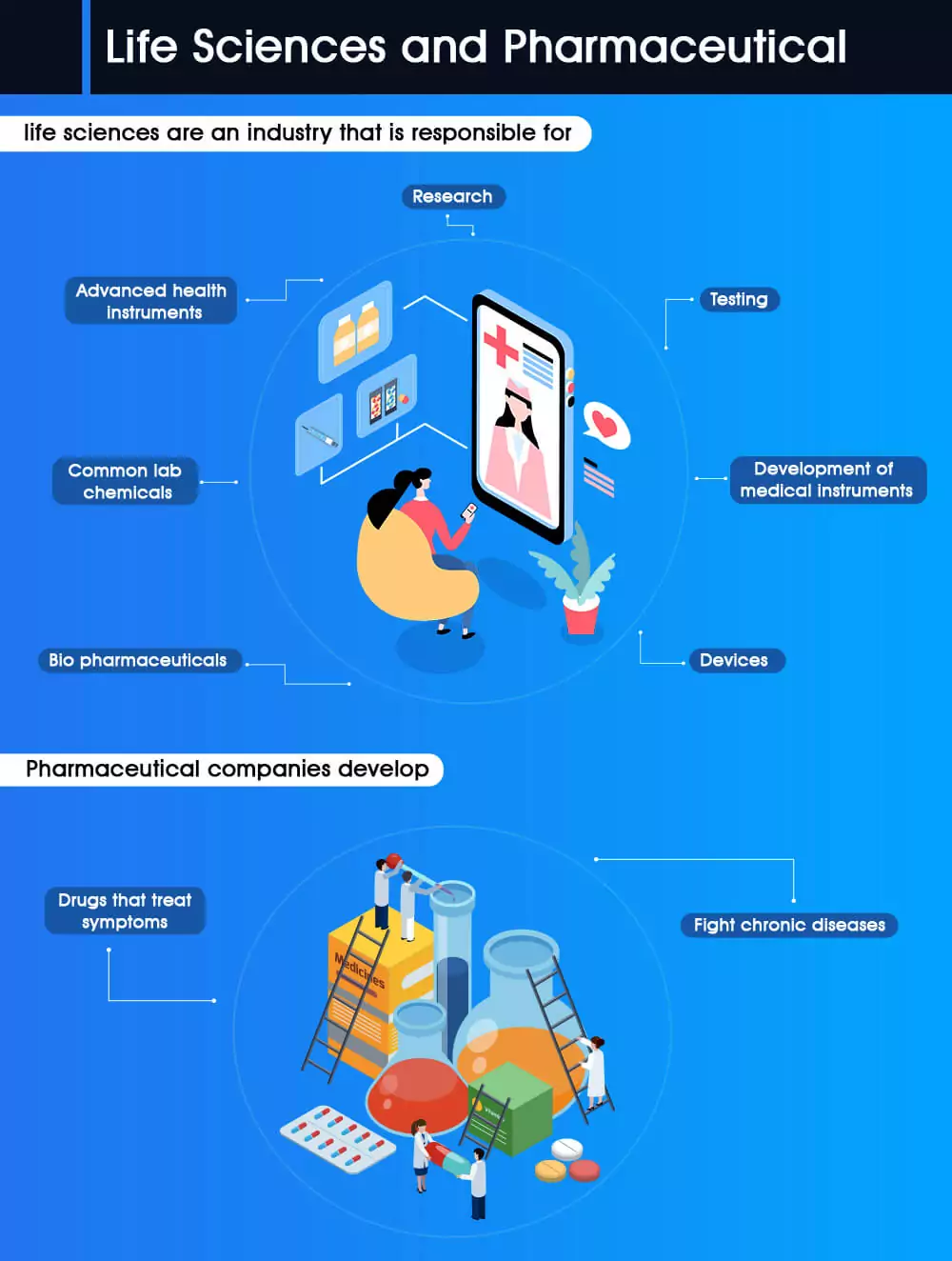
For those of you who are mildly confused about the differences between the two, understand that life sciences are an industry responsible for researching, testing, and developing medical instruments, devices, biopharmaceuticals, advanced health instruments, common lab chemicals, and more.
Pharma, on the other hand, researches, tests, and develops drugs that are either over-the-counter (OTC) or prescribed by doctors. Pharmaceutical companies develop drugs that treat symptoms, fight chronic diseases, and more, and they are subjected to several safety and efficacy protocols.
Now, both are complex in terms of their operations and ride on risky lines. They deal with the direct health and well-being of people and hence cannot afford any mistakes. The vaccines they develop would treat millions, and the devices they roll out monitor the health of billions. With their applications so vast and crucial, this industry has to be airtight in all aspects.
Ironically, several loopholes in their systems and workflows still prevent them from realizing their full efficiency. Today, we will understand exactly what that is.
So, let’s get started. But like usual, let’s get a quick idea of their markets and standings in numbers.
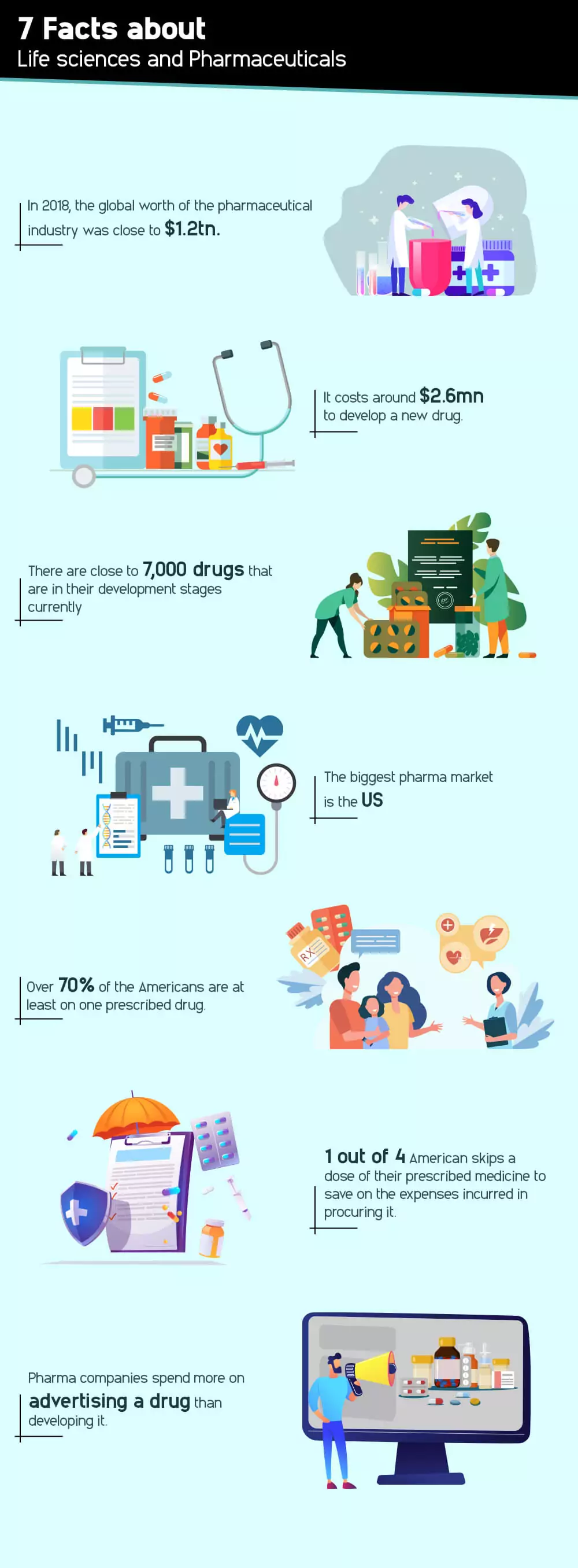
- In 2018, the global worth of the pharmaceutical industry was close to $1.2 trillion.
- It costs around $2.6 million to develop a new drug.
- There are close to 7,000 drugs that are in their development stages currently.
- The biggest pharma market is the US.
- Over 70% of Americans are at least on one prescribed drug.
- One out of four Americans skips a dose of their prescribed medicine to save on the expenses associated with procuring it.
- Pharma companies spend more on advertising a drug than developing it.

Transform the pharma and life science industry with modern technologies and stay ahead of the competition!
Contact Our Experts Now Contact Our Experts NowWhat are the Challenges Faced by the Pharmaceutical and Life Sciences Industries?
compliances, policies, R&D, marketing, administration, coordination, and more involved, it’s probably one of the most hectic industries to be associated with. Every single day, more than one concern is plaguing the operations.
Let’s understand in detail some of the most common challenges.
Streamlining Equipment Servicing
Industries like life science and pharma are heavily equipment-reliant. From the creativity and research of a new drug or a biomedical instrument that happens on paper to running simulations of it and getting 3D-rendered images to its development and manufacturing, the entire industry depends on equipment and its functionality.
Unfortunately, this is one of the industries' first (and major) challenges. The segment lacks a streamlined equipment servicing process, where there is no way to devise servicing calendars or maintenance days in advance. Mostly, servicing happens on a case basis, where they are given attention when equipment malfunctions or begins to show malfunction symptoms. This ends up rattling the entire manufacturing process.
Lack of Coordination With Clinical Trial Patients
Clinical trials are one of the crucial stages in drug research and development. They are where pharmaceutical companies record and process data on whether the new drug or vaccine being developed is actually effective, works on symptoms, shows results, and more. In this process, the data generated has to be in real time to record the most precise developments about the drug and its functionality in the human body.
However, this is not the reality today, as clinical trial patients are still contacted and tracked by obsolete mechanisms (mostly through email, which is not very effective in this industry). This delays recording the progress of the drug’s interaction with bodily fluids and chemicals and gives rise to a report that is either skewed or invalid. The expense, time, and effort channeled into clinical trials are futile. The need for a highly effective and instantaneous clinical trial system is inevitable today.
Accuracy
As segments in healthcare transition towards a more data-heavy mechanism, what becomes crucial is the accuracy at which data is generated, stored, accessed, and retrieved. This refers to the efforts taken by an organization to ensure the accuracy of its data. With cybersecurity still becoming airtight and data being exposed to vulnerabilities and manipulations, there are intense requirements concerning data integrity. Data collected should be original, accurate, attributable, legible, and contemporaneous at any given time. Such integrity not only pushes product quality but patient safety as well. Where there is no data integrity, instances like loss of strategic insights, public trust, plant shutdowns, and others are bound to be attracted.
Operating Costs
According to a report by Deloitte, the price involved in bringing a drug successfully into the market has increased by 25%. This cost surge is the culmination of fragments of costs associated with the operations of all company departments. Machinery, staffing, enterprise software and tools, supply chain, and more costs are incurred at every step. Though none of the stages can be eliminated, digitizing processes can immensely reduce expenses. When smaller shortcomings are addressed and resolved, they lead to an increase in operational efficiencies. An efficient process requires less costs and produces more output. Achieving this is a challenge today.
Delay in Time To Market
The records and insights generated during clinical trials will be pointless if they are not streamlined and put to their purposes. The trials have to follow a systematic process so data is passed on from one stakeholder to the other for the entire process to attain fruition. A disjointed process only delays the process of drug development and manufacturing. In a time like a pandemic, streamlining processes is critical, and the new drug has to be rolled out as early as possible and as effectively as possible. Organizations stuck with obsolete mechanisms can hardly achieve both.
Trend Analysis
Big pharma is always under pressure to stay updated and advanced with evolving technologies. This is mainly because of their market. Companies can be a step ahead of pandemics and viral outbreaks only when they are equipped with advanced technologies and tools. That’s why it is a constant challenge to stay abreast of current happenings and keep an eye out for emerging trends in tech implementations and integrations as well. Such trend analysis will not only help companies stay ahead but also capitalize on any opportunity that comes their way.
Task Assignment
When companies use only emails to assign tasks, it becomes difficult to track conversations during escalations. Though emails get the job done, pharma and life science companies need elements beyond processes that merely get the job done. Technicians and staff cannot be held accountable for emails and are subjected to much bias and intervention. Micromanagement becomes a problem for them. A centralized task allocation process or workflow, where every member of the team and department knows their roles, tasks, accountability, and responsibility, is needed today. This also empowers technicians and staff as they don’t have to wait for orders, which could further delay other processes.
Complain and Reputation Management
Complaint management is key in healthcare. It’s not like broken furniture, where any carpenter could fix it. It’s a highly specialized and science-driven process and results that deal with human lives. Ineffective drugs, malfunctioning medical devices, drugs that induce side effects, and more are problems that big companies need to address and fix. For that, a portal where consumers or businesses could directly file complaints and interact with them is essential. With obsolete mechanisms, complaints hardly take off from the desks of associated staff members. They don’t reach the hierarchy with authority. So, they remain unresolved. When middlemen are eliminated, complaints can be minimized. A portal or a channel is inevitable in this case.
Sales Team Misconduct
Data collected between 1998 and 2016 showed that Big Pharma's spending on lobbying expenses was close to $3bn. It would be unjust to say that misconduct doesn't happen in this segment. Salespeople indulge in malpractices to fetch deals, sign contracts, meet targets, push drug discovery, and more. This goes unnoticed when there is no proper tracking system in place. Call audits, digital surveillance, confidentiality protocols, and other aspects are key in managing and controlling such instances.
Siloed Information
Siloed information refers to insights and information that get stagnated or restricted within one particular department or team. Efficiency can be optimized only when insights are interoperable and put to collective use. When only two teams or departments have access to insights and other stakeholders don’t, and it gives rise to process inaccuracies, delays, and more. What is worse than no information is siloed information, which mainly stems from the lack of a centralized portal or enterprise management system that brings everyone together digitally.
Disconnected Systems and Work Processes
Similar to the above-mentioned point, this is when processes and systems are disconnected. That is, they all operate autonomously with no coordination among them. When five versions are operating for one common goal, the results are not just diverse but disjointed as well. It’s like every single team or department is fixing its version of the jigsaw puzzle.
This puts the organization in a sketchy spot when it comes to legal and compliance issues, as immense coordination is required from teams. In terms of product development and its cycle, such disconnection results in a frustrated environment, where teams develop and deploy modules with variations. Drug research and development could take a heavy hit in such instances.
Collaboration
Collaboration is essential with teams and departments operating out of the same premises globally. When an organization has multiple branches and a team from Singapore has to collaborate with a team in Dallas, coordination becomes all the more crucial. So, regardless of the geography of operation, companies require portals that can connect every single employee with every other seamlessly. Besides this, collaboration is also essential among R&D centers, manufacturing units, and dispatching units to ensure the cycle is complete.
How Digital Transformation can Change Life Sciences and Pharmaceuticals Health Paradigm
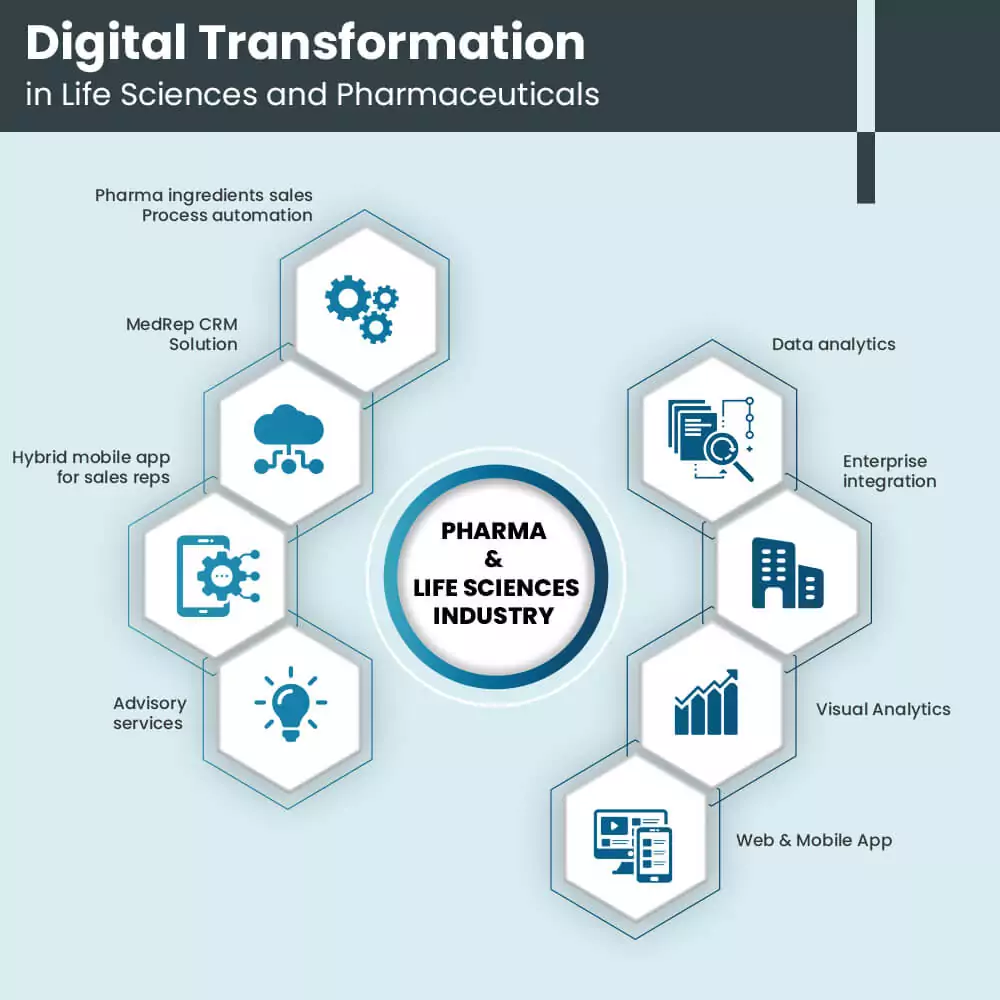
This extensive list of complex challenges has distinct solutions – through digital transformation. Let’s check out some of the implementations.
Enterprise Application Integration
Problems like collaboration, coordination, disjointed processes, and disconnected workflows can be easily addressed and fixed by integrating enterprise applications. An enterprise application is one that the entire business deploys across its operations. Staff use this to log in, mark attendance, check tasks, coordinate, reach out, communicate, schedule meetings, get insights, see progress, and more. With appropriate access, any detail can be retrieved by any employee. An enterprise application streamlines processes and makes data and insights seamlessly accessible to all stakeholders, reducing any associated delays and optimizing interoperability.
Predictive Analytics
Predictive analytics is a data science wing that uses historical data, prevailing trends, and user-generated data to predict outcomes at a given point in time. It uses artificial intelligence (AI) and machine learning algorithms to accurately predict outcomes. With this integration, clinical trials could be simplified, with AI taking care of genome sequencing, synthesis, and simulating outcomes and combinations.
This could accelerate the entire drug development and testing process, as AI is not only foolproof but also precise. AI could also detect how a drug would respond to different body conditions and identify side effects. It’s being increasingly deployed for cancer detection, DNA analytics for hereditary diseases, and more.
Discovery and Preclinical Solutions
The effectiveness of a drug isn’t determined once it is manufactured and rolled out but even before it's noted down on paper. The pharmaceutical market is cluttered with medications today, and so companies have to spend more time identifying different parameters to stand out. Drug discovery is a crucial phase that can be made airtight only with tech implementations. Credible algorithms and enterprise search engines for market research, data mining tools for competitor analysis, and more are required to manufacture and release an effective drug in the market.
Regulatory Compliance
Life science and pharma are complicated industries. There are tons of intricacies involved in terms of regulations, legalities, and compliances. Most associates go into these protocols and practices in compiling documentation and paperwork. However, this could be simplified and streamlined with automation, where compliance and statutory obligations could be listed and automated for collection, processing, and compiling of paperwork and documentation. Human intervention can be brought in to verify the outcomes and take the processes further.
Multi-channel Marketing

There are several avenues for companies to reach out to their target companies and consumers. There are PR, professional networking tools, social media for corporate social responsibilities (CSR) features, and more. On each channel, the tone, approach, and content vary. What sounds too technical in a PR piece could be simplified for social media and video streaming channels. With so many channels involved, generating and distributing content becomes a mess. That’s why a centralized content management system with built-in content calendars and automation tools could save marketing people tons of time executing tasks and focus more on ideating campaigns.
AI and ML For Medical Information
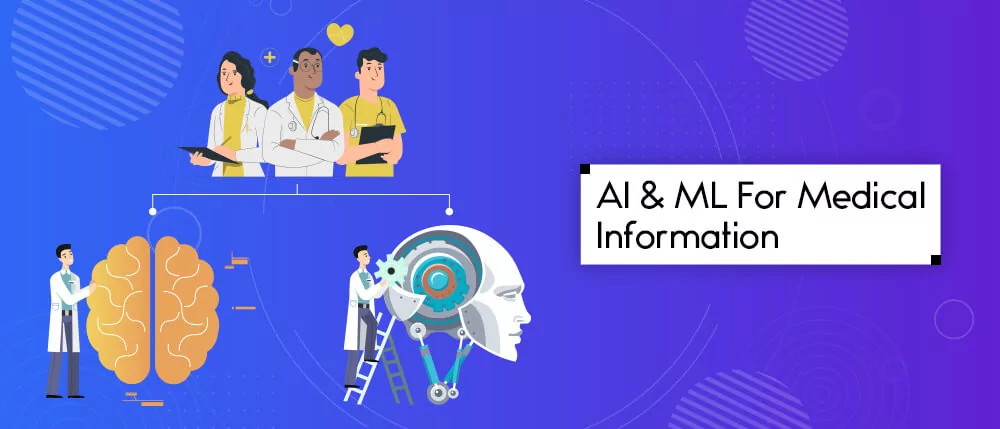
Medical information takes a distinct meaning in different departments. From a patient perspective, this means their electronic health record carries information like patient name and demographics, health history, allergies and symptoms, diseases running in the family, and more. From a pharma perspective, this means insights and information related to drugs in terms of their composition, strength, dosage, effectiveness, clinical trials and versions, mutations, evolutions, side effects, and more.
For both ends to meet effectively, the right drug has to be prescribed for the right symptoms, and this is where AI and ML could simplify the entire process. They could make data interoperability more possible, detect mutations and diseases beforehand, and suggest the right medication that doctors could verify and then prescribe. Prescriptive and predictive analytics could work in tandem for this.
Benefit and Risk Management
Pharma and life science companies could cut their budget and time spent on product development by implementing the benefits and risk management phase. This systematic process involves assessment, controlled communication, and review of the risks and benefits of the final product under development. This report gives a clear idea of the quality of the product. It paves the way for optimized communication and reduced budget as it eliminates assumptions and introduces data-driven decisions, simplified escalation management, and more.
Integrate modern technologies and tools to expand the processes of life science and the medical industry.
Wearable Tech
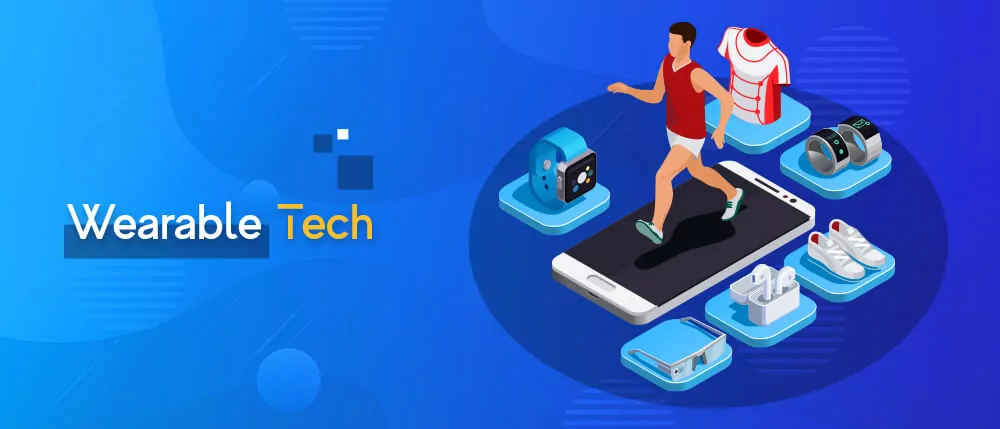
The future is gradually unfolding right in front of our eyes. Our smartphones have functionalities that can monitor and track our health. Wearable devices like FitBits, smart pacemakers, and more can be connected to our smartphones (through apps) to consistently track health details and use predictive analytics to signal when something is about to go wrong.
This signal could notify doctors and families registered on the phone along with electronic health records for physicians and specialists to work on without relying on other sources of information. If you didn’t know, devices like the Apple Watch have saved people from heart attacks by predicting minutes before the incident.
RPA in Clinical
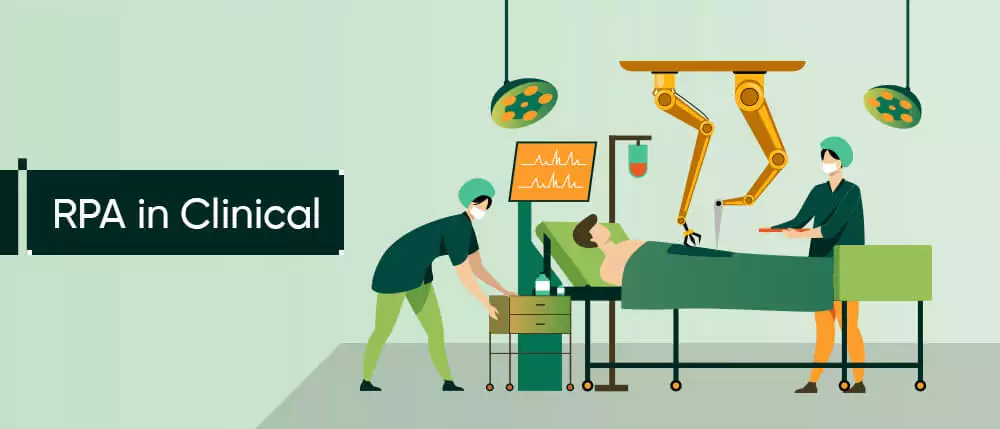
The term RPA stands for Robotic Process Automation and involves the deployment of artificially intelligent bots and robots to manage complex processes and mechanisms. In clinical trials, RPAs can be used to minimize the time required to complete trials, increase success ratios, improve patient matching and co-vigilance, improve regulatory processes, and more. They are also used to automate supply-chain processes in pharma. RPA helps save time and millions annually on expenses like trials, retrials, fines, legal expenses, etc.
Case Study
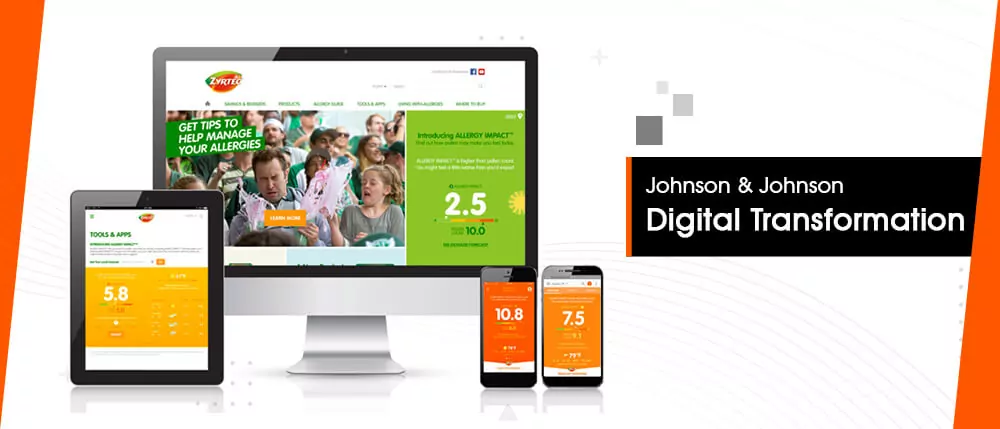
Johnson & Johnson (J&J) has been a household name for decades. People across the world are familiar with the brand, its value, and its product quality. With over 250 companies under its name, it recently reidentified itself as a health tech innovator as well.
It implemented tech to improve patient care and healthcare outcomes. To get started, it rolled out diverse digital tools that, using technology and clinical knowledge, guided patients in their healthcare journey.
For instance, it rolled out an app called Remote Assessment in Rheumatoid Arthritis that leveraged the potential of a wearable device like Fitbit. By consistently monitoring and collecting health information through the device, the app processed the data to assess and notify the patient of the medication's effect on them and tell them if their condition was worsening or improving.
To help people suffering from diabetes, it also rolled out an app called Reveal, which allows patients to monitor and control their blood sugar levels. This works in tandem with J&J’s one-touch glucometer.
The company is also venturing into robotics by developing cost-efficient surgical robots. By collaborating with Verb Surgical for this purpose, it aims to perform 75 to 90% of surgeries in the future with robots. Currently, the number is less than 5%.
Future Of Life Science And Pharma
The life science and pharma segments have an interesting future ahead of them, with increased integrations of technologies like big data, artificial intelligence, machine learning, deep learning, RPAs, the Internet of Medical Things, and more. As the race to drug discovery increases, we can also see the introduction of blockchain in pharma to make drug manufacturing, patents, chemical compositions, and synthesis processes more discreet and internal.
Complaint management would also involve the deployment of bots that could mimic human interaction with accurate information. Data analytics would be at the heart of most processes, from patient care and drug research and development to marketing. We would also witness the onset of tech like augmented reality and virtual reality to study molecular composition and crystal structures in detail for educational and research purposes.
How Exciting Does That Sound?
The world of life science and pharma could be chaotic from the outside, but the rewards are priceless. Imagine when Big Pharma cracks a vaccine for COVID-19 after months of internal struggle. If you aspire to change the world with your pharma or life science idea, you first need a tangible solution in the form of an app or software application. And to get that developed, you need industry veterans like us.
Contact us today to turn your idea into a potential game-changer in the pharma industry.
